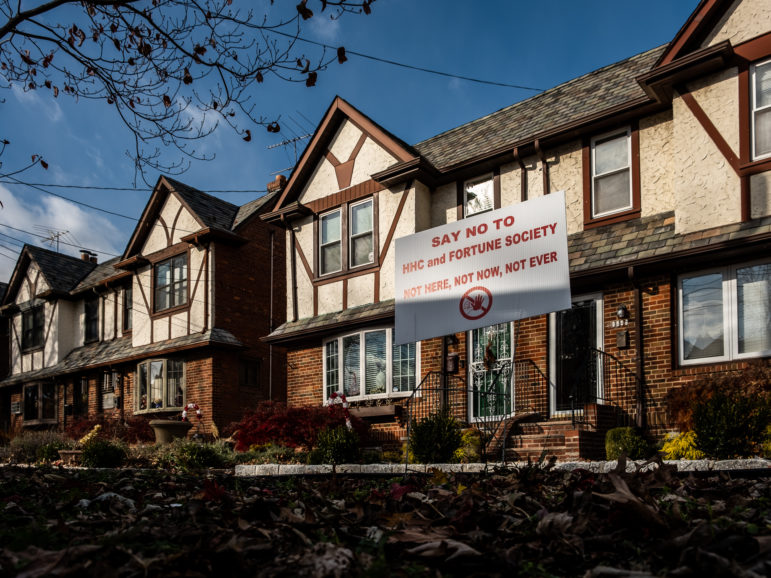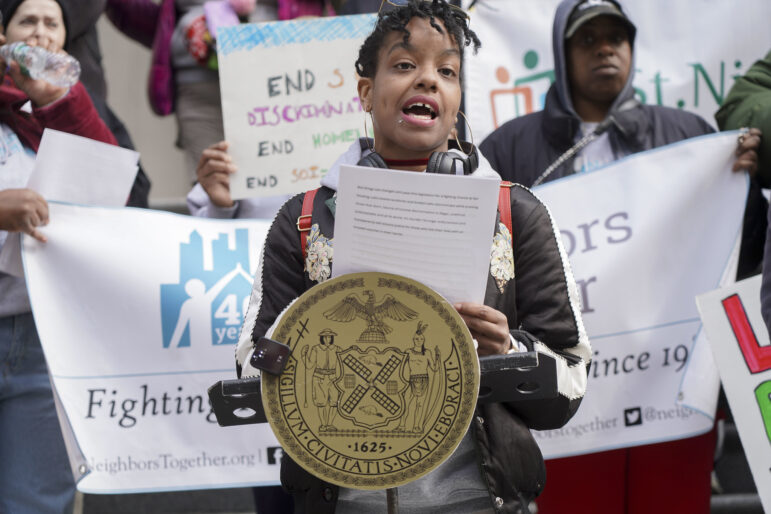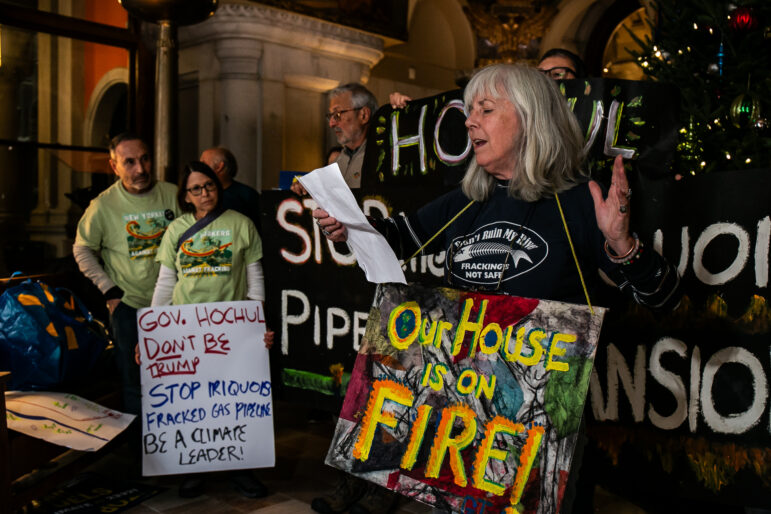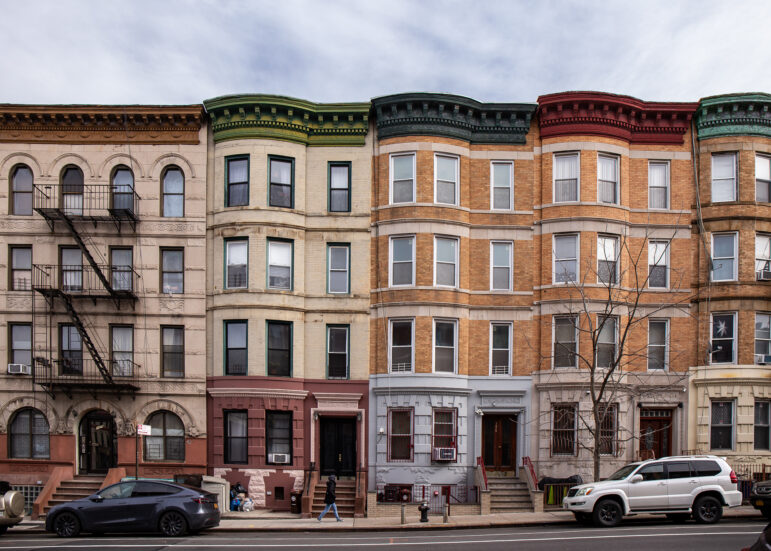The rate increase, National Grid argues, is necessary for maintaining service as safe and reliable for customers. But environmentalists question adding gas hookups and revamping the system when New York is supposed to be phasing out polluting fossil fuels, as mandated by the state’s landmark climate law.

Adi Talwar
Tanks filled with liquid gas emerge from behind a wall of fences and barbed wire at National Grid’s facility in Greenpoint.Shauria Rivera rocked her baby girl in a stroller outside of Cooper Park Houses, the public housing complex she calls home in Brooklyn’s Greenpoint neighborhood.
As she watched her daughter fall asleep, the 28-year old law student and mother of two told City Limits she worried about living across the street from a Liquefied Natural Gas (LNG) facility, where gas is distributed and turned into liquid for storage. Known as the Greenpoint Energy Center, the site is run by National Grid, one of New York’s largest gas utility providers.
“It sounds like it should be good for you because they call it natural gas. But it’s not good for you at all,” Rivera said.

Adi Talwar
Shauria Rivera, a mother of two who lives at NYCHA’s Cooper Park Houses, a public housing development in Brooklyn’s Greenpoint neighborhood across the street from where National Grid distributes and stores liquefied gas.LNG facilities release air pollutants like carbon monoxide, sulfur dioxide, and volatile organic compounds (VOCs). Long term exposure to these compounds, some studies warn, can lead to heart disease, cancer, and can damage internal organs and the reproductive system. Using gas for energy also creates greenhouse gas pollution, which drives climate change.
“I want [my kids] to at least have a shot at a healthy life. You can’t guarantee everything, but at least that should be guaranteed,” Rivera added.
But starting Sept. 1, National Grid customers across New York City will see their monthly bills go up to help pay for approximately $5 billion in new investments to the gas system, including upgrades to the Greenpoint site, according to the company. A rate case, or a proceeding to raise utility rates to cover those costs, was approved Thursday by the Public Service Commission, the state’s utility regulator.
Customers who use gas to heat their homes will see, on average, an extra $30.18 charged to their monthly bills in Brooklyn, portions of Queens, and Staten Island. An estimated additional $9.61 will be charged the following year, and an extra $22.09 will be tacked on in 2026.
The rate increase, the company argues, is necessary for maintaining the system as safe and reliable for customers. But energy experts say much of these costs could be avoided by repairing old pipes instead of replacing them and rethinking the design of the LNG facility so less money is spent on using it.
And they question adding new gas hookups when New York is supposed to be phasing out polluting fossil fuels by 2050, as mandated by the state's landmark climate law, the Climate Leadership and Community Protection Act (CLCPA).
Since the CLCPA was passed, the state agency has negotiated 12 proceedings to increase the cost of gas bills across New York, including last week’s National Grid decision, a City Limits review of these cases found. And although the PSC modified the rate hikes to lower than those originally requested by gas companies, they were ultimately approved.
"We are continuously investing in the types of infrastructure that harm our climate and that harm the health and safety of disadvantaged communities," said Kim Fraczek, an East Williamsburg resident and director of the environmental group, Sane Energy Project.
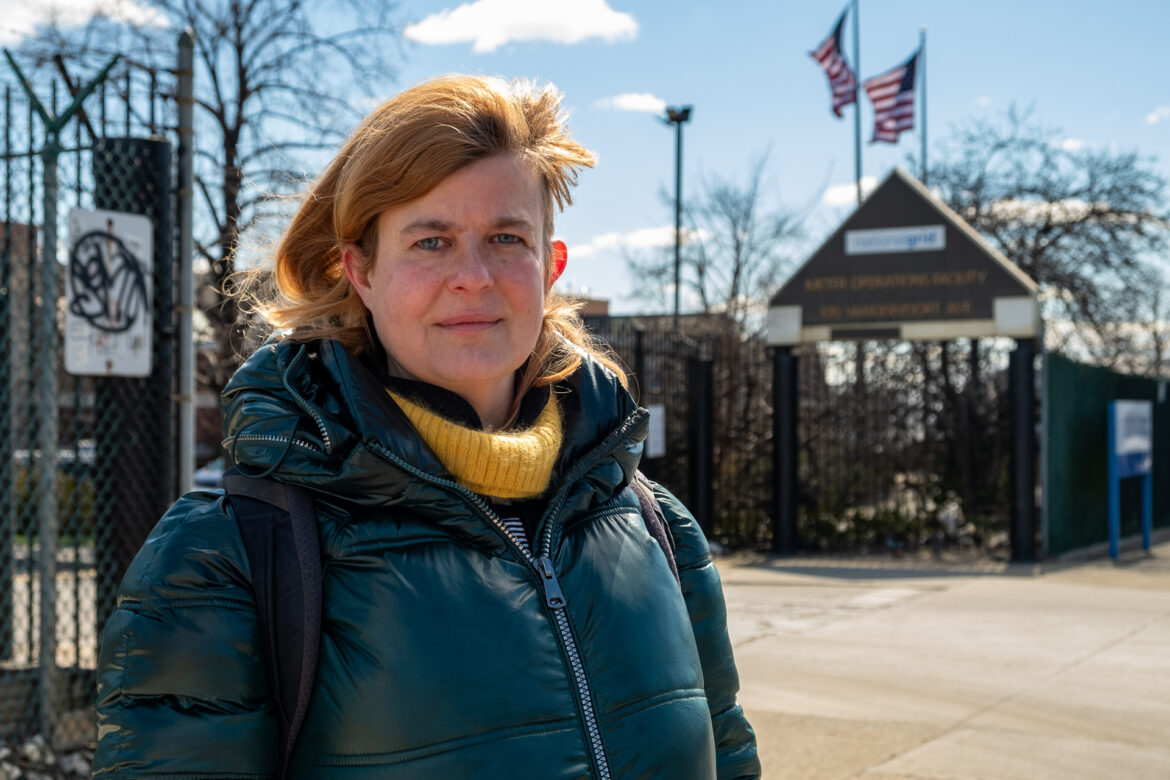
Adi Talwar
Kim Fraczek, an East Williamsburg resident and director of the environmental group Sane Energy Project, outside National Grid's LNG Facility.‘We don't ask for more than we think is necessary’
Using a sleek all-white virtual living room as his Zoom backdrop, Philip DeCicco, vice-president of National Grid's New York branch, dug into why the rate hike is needed.
"[Most] of the investments that we're proposing are items that we are effectively obligated or mandated to do under current regulatory regimes and safety requirements," Deccico said during an interview with City Limits earlier this month.
The British-owned utility is one of the largest gas providers in the northeast U.S., serving more than 20 million people throughout New York and Massachusetts, including 1.9 million customers across Brooklyn, Staten Island, parts of Queens and Long Island.
"We don't ask for more than we think is necessary," DeCicco concluded.
The $5 billion upgrades include an estimated $271 million that will be poured into renovating the Greenpoint LNG facility, another $405 million towards the installation of new gas hookups and $1.5 billion to replace old pipes with long-lasting plastic ones, according to National Grid.
But energy experts have questioned the necessity of charging ratepayers to replace 531 miles of underground infrastructure known as “leak-prone pipe” (LPP), made mostly of old unprotected steel and cast iron.
These investments are part of a larger plan to retire over 1,400 miles of LPP by 2045 and replace them with new plastic pipes made of High Density Polyethylene (HDPE). The mass replacement is "warranted," National Grid argued in public filings, because LPPs are responsible for 95 percent of the leaks that are repaired in its service territory.
The new pipes, however, have a useful lifespan of 75 years, tethering ratepayers to the gas system for decades to come despite climate mandates to phase out its use, experts warn.
"There's a huge risk that we're going to put in this brand new pipe, but we are not going to use it for its entire useful life," said Chris Casey, utility regulator director at the non-profit Natural Resources Defense Council (NRDC).

Adi Talwar
Environmental groups led a protest in Greenpoint's polluted Newtown Creek against rate increases proposed by National Grid on June 2, 2024."Future customers are going to have to pay for those stranded costs even when they're not being served by that pipe," he added.
On average, it costs New York gas utilities over $3 million per mile to install a gas distribution main, or the maze of pipes that snake through a company’s service territory, according to the Building Decarbonization Coalition.
Instead of replacing large stretches of pipe for a hefty price tag, experts suggest they could be repaired by lining them with a sleeve, or coating them from the inside. Robots can be used to get the job done, and a tool known as keyholing can create a small opening in a street or sidewalk to carry out pipeline maintenance without excavation.
But it's in a utility company's best interest to keep investing in pipe replacements instead, economists say. "Gas companies don't earn any profit on repairing or renewing pipes, that's the ultimate thing at work here," said Dorie Seavey, economist and senior research scientist at Groundwork Data.
The real profit, Seavey explains, is made from adding more infrastructure to the system. Gas companies front the money to build these assets, and then customers are stuck paying them back for the investment.
That includes paying back money that any investors may have lent for the venture, plus the rate of return they are allowed to make on the borrowed capital. The utilities also issue bonds to help finance these projects, and customers are on the hook for covering the cost of that debt too.
Meanwhile, the assets generate money for gas companies as they earn their own rate of return on each investment. So the more infrastructure a utility has, the more profit it makes.
Over the past three years, National Grid has consistently replaced more LPP than the minimum required by the PSC "to maintain safe and reliable service," the utility regulator told City Limits. Between 2020 and 2023, the company swapped out a total of 683 miles, when the PSC said the minimum requirement was 671.
National Grid, however, says that the more LPP it replaces, the better it is for the environment, as it curbs the gas leaks that generate greenhouse gas emissions.
"Since 2013, National Grid has replaced 1,500 miles of gas main, lowering system emissions by 102,385 metric tons of CO2e which is equivalent to removing 22,257 cars from the road," a spokesperson told City Limits in an email.
But going electric, making buildings more energy efficient and getting rid of entire gas pipelines "could reduce emissions at a cost per ton that is 77 percent less expensive than the cost per ton of the main pipe replacement," according to a 2022 analysis of a Con Edison case, conducted by Alice Napoleon and Dr. Asa Hopkins at Synapse Energy. The same argument applies to National Grid’s efforts, experts said.
Still, utilities have continued expanding even though the state's climate law, the CLCPA, mandates New York move away from fossil fuels. Since the law's passing in 2019, utility companies have spent nearly $5 billion to maintain and expand gas infrastructure and plan to spend another $28 billion by 2043, according to a report by the Building Decarbonization Coalition.
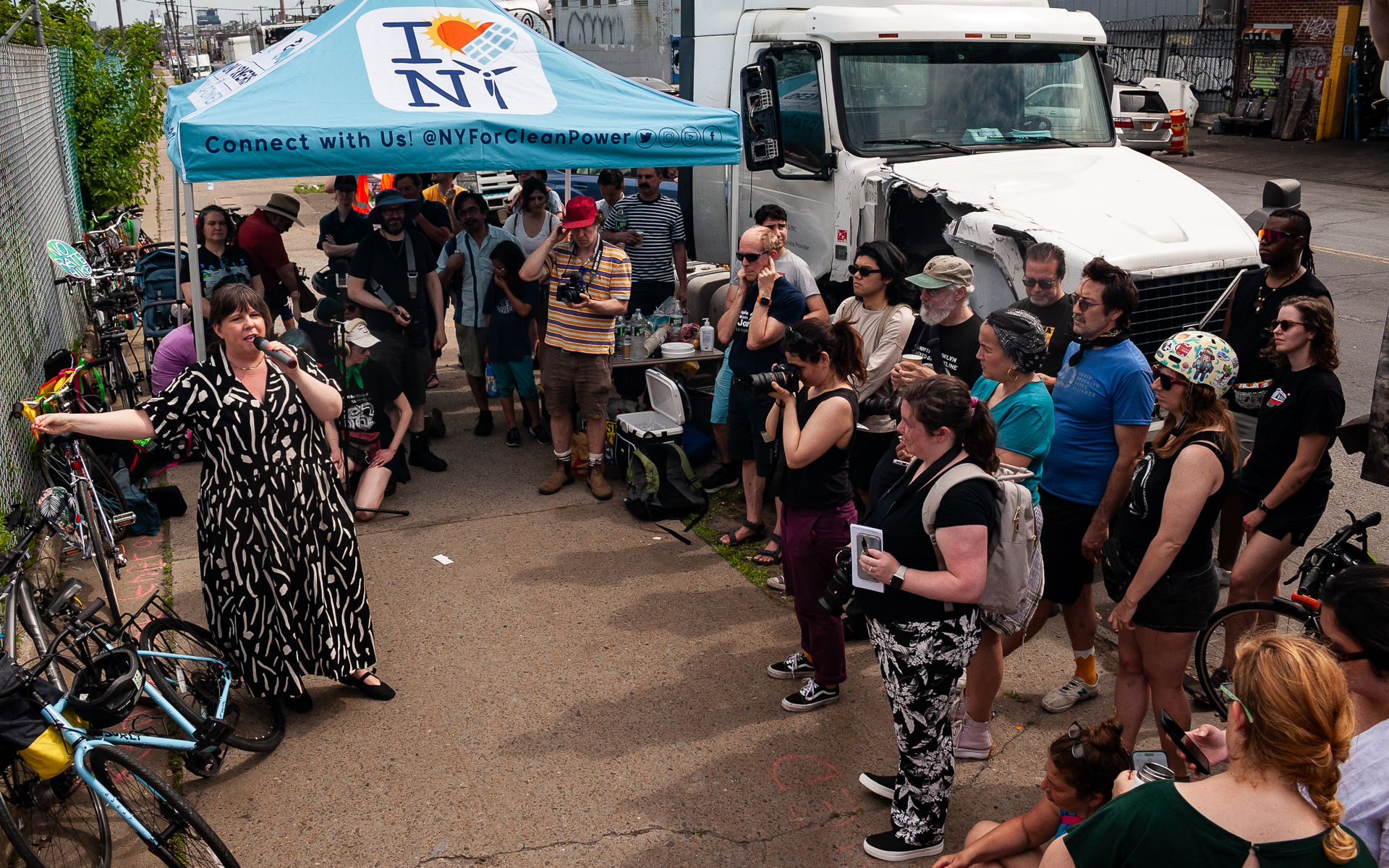
Adi Talwar
Assemblymember Emily Gallagher speaks in opposition to the expansion of gas infrastructure projects and National Grid's rate hike at a June protest.At a time when the state is moving away from gas, utilities put new infrastructure in place to guarantee profits, Greenpoint Assemblymember Emily Gallagher says.
"We are basically receiving a service that we didn't necessarily want or we didn't ask for. And we're having our rates raised to create profit for an investor class that is not even here," Gallagher said.
Bearing the burden of expansion
In early June, Gallagher joined dozens of environmental activists in front of National Grid's 85-acre Liquefied Natural Gas (LNG) in Greenpoint. Like a scene from a science fiction movie, rounded white tanks filled with liquid gas emerge from behind a wall of fences and barbed wire.
The facility has become a symbol for the billions in ratepayer dollars that the company plans to spend on its new infrastructure projects, with approximately $271 million to be spent on renovating the LNG campus itself.
Home to more than a century of industrial activity, the Greenpoint area has already been subjected to oil spills and groundwater contamination and was deemed a disadvantaged community by the state's environmental authorities.
"To tell us that they want to refurbish this equipment that has already been creating toxins in the neighborhood is just completely insulting to our well being," Fraczek told City Limits after leading the crowd in protest.
"The plant has been in service for more than 50 years and requires upgrades to support continued safe and reliable operation," National Grid explains in a document included in the rate case.
Plants like this one are supposed to only serve customers during peak demand—when the gas system is overworked because of high usage, like on very cold winter days when New Yorkers need extra gas to heat their homes.
"It makes sure that our system is there to meet customer [demand] on the coldest days of the year when customers rely on us for life sustaining energy," National Grid's DeCicco said.
Other utilities across the northeast agree. "These facilities are critical to ensure energy reliability for all New York homes and businesses," the Northeast Gas Association told City Limits in an email.
But the LNG campus isn't being used to its full capacity, according to expert testimony submitted by environmental group Alliance for a Green Economy (AGREE).
The facility can deliver gas to its customers that is equivalent to up to 250,000 million MMBtus, a unit of measurement for energy. But over the last 10 years, the Greenpoint energy center has only delivered 100,000 million MMBtus.


Left: Protestors at a rally that took place in front of National Grid's Liquefied Natural Gas (LNG) facility in June, opposing the expansion of gas infrastructure in New York City. Right: The entrance to National Grid's LNG facility known as the Greenpoint Energy Center. Photos by Adi Talwar.
That means that over the last decade it has been providing gas on only 7.7 percent of the days that it could have, the group's testimony explains, saying the facility is not operating at its full capacity because it was designed to meet an unrealistic demand.
The facility was made to be used when the temperature outside reaches 65 Heating Degree Days (HDD), a measurement used by gas companies to signal how much energy is needed to heat buildings.
This measurement is equivalent to the temperature at Central Park reaching zero degrees over the course of an entire day. The last time that happened in New York was in 1934, AGREE’s testimony warns.
Community members in Greenpoint have been pushing National Grid to rethink the facility's design. They argue that this would allow less ratepayer dollars to be spent on making it operate at an unnecessary capacity.
"They're using a calculation to measure the need of the facility that is dated and disingenuous," said Willis Elkins, executive director of the Newtown Creek Alliance, an environmental group geared at cleaning up Greenpoint's polluted Newtown Creek.
In its final decision on the rate case, the PSC said that it "will comprehensively assess the continued need" for the facility, but approved the proposed projects for now. Those who hoped for greater structural change view the terms of the agreement as a loss for the community.
"National Grid makes most of their profits from infrastructure build-out. And this rate case is all about them being able to continue that infrastructure build-out whether we need it or not," Elkins said.
The bigger picture
Holding signs that read "we won't pay to be poisoned," environmental activists stepped in front of PSC's commissioners when the rate case was approved last Thursday. They questioned the need to expand gas infrastructure on a larger scale, especially since around $405 million will go towards connecting new customers to the system.
"We do not actively market gas hookups and we encourage customers to explore alternatives to gas, but ultimately if a customer wants to be connected to the gas system, we are legally obligated to provide service," a National Grid spokesperson said in an email.
This legal obligation to serve gas is a justification the company has used time and again. The state’s public service law currently requires gas utilities to provide gas service at no charge to anyone who wants it and lives within 100 feet of an existing line.
To keep the public service law from overriding the state's landmark climate law, environmental groups worked hard this year to pass the New York Heat Act. The legislation has the power to amend the public service law and open utility companies up to offering non-polluting energy alternatives to customers.
The bill failed to pass this legislative session and received immense opposition from gas utilities like National Fuel and the trade association New Yorkers for Affordable Energy, which spent over $100,000 in ads to campaign against it.

Brynn Fuller-Becker
Climate activists rallied for the passage NY Heat Act in the state budget in March.The state's utility regulator, the PSC, has taken a quieter stance on the issue, telling City Limits in an email that it "takes its role in meeting the requirements outlined in the Climate Act seriously."
The agency "will continue evaluating the gas system as a whole and identifying the investments needed to maintain safe and reliable service, while also investing in a clean energy grid,” a spokesperson added.
The environmental community fears that the longer utilities are able to use the obligation to serve gas as a motive, gas infrastructure will continue to be built out, sticking ratepayers with the costs as more rate increases pile on.
The PSC has weighed in on 12 requests to hike up customer rates in New York State since the CLCPA was passed. The utility regulator points out that although these were approved, the agency heavily negotiated them, talking down gas companies’ original requests and securing more reasonable rate increases.
After Thursday's rate case was approved, the PSC pointed out in a press release that it reduced the National Grid's "initial request" by 37 percent. Since the passage of the CLCPA, the PSC has "dramatically reduced initial gas rate requests in the first year of the rate case by more than $759 million," the agency said in an email.
"All rate cases have been weighed and considered under the requirements set forth by New York’s nation-leading clean energy goals that will create an orderly and just transition to clean energy, create jobs, and spur a green economy," the commission added.
The proposal for the rate hike approved Thursday was also "consistent with the CLCPA's objectives and will not disproportionately burden disadvantaged communities," the PSC's administrative judge, Maureen Leary, said at the decision.
National Grid also swears by its desire to uphold the standards of the CLCPA and says it’s "committed to initiatives that support a just and affordable clean energy transition."
The company estimates that the newly approved rate case will result in the reduction of over 880,000 metric tons of the greenhouse gas carbon dioxide in Brooklyn, portions of Queens, and Staten Island. Another nearly 788,000 metric tons will be reduced in Long Island and the Rockaways, and the rate plan allocates an average of $75 million per year to help customers weatherize their homes and limit their energy consumption.
But many carbon-free initiatives that the PSC has requested utility companies take on in the past haven't amounted to much, environmentalists argue.
In 2019, for instance, the PSC ordered National Grid to identify five segments of leak-prone pipe annually that could be replaced with non-pipe alternatives. But none have been replaced so far, according to DeCicco.
"We haven't been incredibly successful doing that. And so we're looking for ways in collaboration with stakeholders to really lean into that," DeCicco told City Limits.
These efforts are an example of the "tiny incremental" modifications that the PSC is adding to rate cases to justify approving hikes in spite of the CLCPA, Jessica Azulay, executive director of AGREE says.
"So instead of denying investments in gas infrastructure or ordering massive programs to help people voluntarily move off of the system, [the PSC] is approving utility plans that have little incremental changes," Azulay explains.
"But even those wins, if you add them up, it's a drop in the bucket. It’s like they are slowing the rate of growth, but they are not turning the tide and actually reducing [gas consumption]."
To reach the reporter behind this story, contact Mariana@citylimits.org. To reach the editor, contact Jeanmarie@citylimits.org
Want to republish this story? Find City Limits’ reprint policy here.


